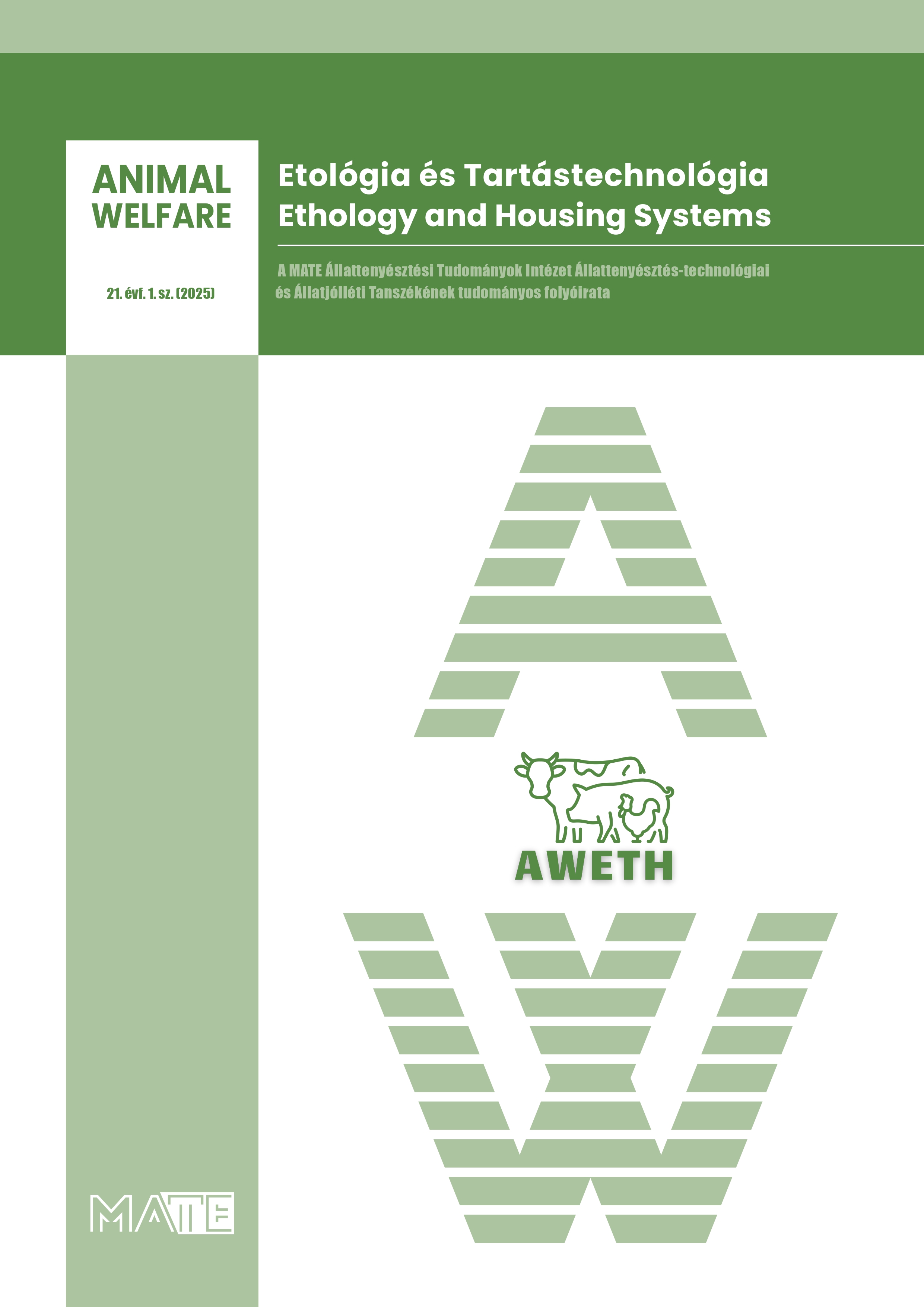Szarvasmarha in vitro embrió-előállító rendszer létrehozása ku-tatási modellkísérletek számára – módszertani ismertető
DOI:
https://doi.org/10.17205/aweth.7060Kulcsszavak:
szarvasmarha, in vitro embrió-előállítás, in vitro modellrendszerAbsztrakt
Az in vitro embrió-előállítás (IVEP) 40 éves töretlen fejlődésének köszönhetően napjainkra egyre fontosabb szerepet tölt be a világ szarvasmarha-tenyésztésében. A petesejtek kinyerése, laboratóriumi körülmények között történő termékenyítése, az embriók tenyésztése, a krioprezerváció, illetve a laboratóriumi környezet terén elért fejlődés több millió genetikailag magas értékű egyed előállítását tette lehetővé. Gyakorlati alkalmazási lehetőségei mellett az in vitro embrió-előállítás (IVEP) számos kutatás alapját biztosítja. Segítségével a korai vemhességi időszak modellezhető, az embriófejlődés környezeti tényezői tanulmányozhatók, így olyan kérdésekre kaphatunk választ, melyek a tudományos és gyakorlati szakemberek számára is fontosak. Egy megbízhatóan működő embrió előállító rendszer kialakítása során sok technológiai lépés optimalizálására van szükség. Az elmúlt év során a szerzőknek sikerült kialakítaniuk egy olyan, jól működő rendszert, melyben sikeresen folyik a szarvasmarha embriók előállítása, így oktatási, kutatási feladatok megvalósítására alkalmas. A közleményben a szerzők bemutatják a rendszer kialakítását egészen a kezdetektől, ennek sikereit és buktatóit egyaránt, valamint beszámolnak az itt végzett 31 IVEP program eredményességéről. A kialakított rendszerben átlagosan a termékenyített petesejtek 69%-a osztódik, és 23,4%-a fejlődik beültethető állapotú hólyagcsíráig, így alkalmas ovum pick-up (OPU) IVEP programok megvalósítására is.
Hivatkozások
Bittner, L., Wyck, S., Herrera, C., Siuda, M., Wrenzycki, C., van Loon, B., Bollwein, H. (2018): Negative effects of oxidative stress in bovine spermatozoa on in vitro development and DNA integrity of embryos. Reproduction, Fertility and Development, 30, 1359–1368. https://doi.org/10.1071/RD17533
Bousquet, D., Twagiramungu, H., Morin, N., Brisson, C., Carboneau, G., Durocher, J. (1999): In vitro embryo production in the cow: an effective alternative to the conventional embryo production approach. Theriogenology, 51, 59–70. https://doi.org/10.1016/S0093-691X(98)00231-3
Brackett, B. G., Bousquet, D., Boice, M. L., Donawick, W. J., Evans, J. F., Dressel, M. A. (1982): Normal development following in vitro fertilization in the cow. Biology of Reproduction, 27, 147–158. https://doi.org/10.1095/biolreprod27.1.147
Cairo Consensus Group (2018): ‘There is only one thing that is truly important in an IVF laboratory: everything’ Cairo Consensus Guidelines on IVF Culture Conditions. Reproductive BioMedicine Online, 40, 33–60. https://doi.org/10.1016/j.rbmo.2019.10.003
Ferré, L. B., Kjelland, M. E., Strøbech, L. B., Hyttel, P., Mermillod, P., Ross, P. J. (2020): Review: Recent advances in bovine in vitro embryo production: reproductive biotechnology history and methods. Animal, 14, 991–1004. https://doi.org/10.1017/S1751731119002775
Greve, T., Madison, V. (1991): In vitro fertilization in cattle: a review. Reproduction, Nutrition and Development, 31, 147–157. https://doi.org/10.1051/rnd:19910205
Hallberg, I., Kjellgren, J., Persson, S., Örn, S., Sjunnesson, Y. (2019): Perfluorononanoic acid (PFNA) alters lipid accumulation in bovine blastocysts after oocyte exposure during in vitro maturation. Reproductive Toxicology, 84, 1–8. https://doi.org/10.1016/j.reprotox.2018.11.005
Halstead, M. M., Ma, X., Zhou, C., Schultz, R. M., Ross, P. J. (2020): Chromatin remodeling in bovine embryos indicates species-specific regulation of genome activation. Nature Communications, 11, 4654. https://www.nature.com/articles/s41467-020-18508-3
Hansen, P. J. (2006): Realizing the promise of IVF in cattle - an overview. Theriogenology, 65, 119–125. https://doi.org/10.1016/j.theriogenology.2005.09.019
Hawke, D. C., Watson, A. J., Betts, D. H. (2021): Extracellular vesicles, microRNA and the preim-plantation embryo: non-invasive clues of embryo well-being. Reproductive Biomedicine Online, 42, 39–54. https://doi.org/10.1016/j.rbmo.2020.11.011
Isaac, E., Berg, D. K., Pfeffer, P. L. (2024): Using extended growth of cattle embryos in culture to gain insights into bovine developmental events on embryonic days 8 to 10. Theriogenology, 214, 10–20. https://doi.org/10.1016/j.theriogenology.2023.10.004
Jiang, Z. (2024): Molecular and cellular programs underlying the development of bovine preimplantation embryos. Reproduction, Fertility and Development, 36, 34–42. https://doi.org/10.1071/RD23146
Langbeen, A. N., Hannelore, F. M. D., Bartholomeus, E., Jo, L. M. R. L., Peter, E. J. B. (2015): Bovine in vitro reproduction models can contribute to the development of (female) fertility preservation strategies. Theriogenology, 84, 477–489. https://doi.org/10.1016/j.theriogenology.2015.04.009
Lange-Consiglio, A., Lazzari, B., Pizzi, F., Idda, A., Cremonesi, F., Capra, E. (2020): Amniotic microvesicles impact hatching and pregnancy percentages of in vitro bovine embryos and blastocyst microRNA expression versus in vivo controls. Scientific Reports, 10, 501. https://doi.org/10.1038/s41598-019-57060-z
Lopera-Vasquez, R., Hamdi, M., Maillo, V., Gutierrez-Adan, A., Bermejo-Alvarez, P., Ramírez, M. Á., Yáñez-Mó, M., Rizos, D. (2017): Effect of bovine oviductal extracellular vesicles on embryo development and quality in vitro. Reproduction, 153, 461–470. https://doi.org/10.1530/REP-16-0384
Menezo, Y. J., Herubel, F. (2002): Mouse and bovine models for human IVF. Reproductive Biomedicine Online, 4, 170–175. https://doi.org/10.1016/s1472-6483(10)61936-0
Menjivar, N. G., Gad, A., Gebremedhn, S., Ghosh, S., Tesfaye, D. (2023): Granulosa cell-derived extracellular vesicles mitigate the detrimental impact of thermal stress on bovine oocytes and embryos. Frontiers in Cell Developmental Biology, 11, 1142629. https://doi.org/10.3389/fcell.2023.1142629
Pinzón-Arteaga, C. A., Wang, Y., Wei, Y., Ribeiro Orsi, A. E., Li, L., Scatolin, G., Liu, L., Sakurai, M., Ye, J., Ming, H., Yu, L., Li, B., Jiang, Z., Wu, J. (2023): Bovine blastocyst-like structures derived from stem cell cultures. Cell Stem Cell, 30, 611–616, e7 https://doi.org/10.1016/j.stem.2023.04.003
Sirard, M. A. (2018a): The influence of in vitro fertilization and embryo culture on the embryo epigenetic constituents and the possible consequences in the bovine model. Journal of Developmental Origins of Health and Disease, 8, 411–417. https://doi.org/10.1017/s2040174417000125
Sirard, M. A. (2018b): 40 years of bovine IVF in the new genomic selection context. Reproduction and Fertility, 156, R1–R7. https://doi.org/10.1530/rep-18-0008
Sirard, M. A., Lambert, R. D. (1986): Birth of calves after in vitro fertilisation using laparoscopy and rabbit oviduct incubation of zygotes. Veterinary Record, 119, 167–169. https://doi.org/10.1136/vr.119.8.167
Sirard, M. A., Parrish, J. J., Ware, C. B., Leibfried-Rutledge, M. L., First, N. L. (1988): The culture of bovine oocytes to obtain developmentally competent embryos. Biology of Reproduction, 39, 546–552. https://doi.org/10.1095/biolreprod39.3.546
Speckhart, S. L., Wooldridge, L. K., Ealy, A. D. (2023): An updated protocol for in vitro bovine embryo production. Cell Press STAR Protocols 4, 101924. https://doi.org/10.1016/j.xpro.2022.101924
Letöltések
Megjelent
Folyóirat szám
Rovat
License
Copyright (c) 2025 Nagy Katalin, Tokár Alexandra, Sándorová Lilla, Gócza Elen, Zomborszky Zoltán, Stéger Viktor, Szabari Miklós, Póti Péter, Bodó Szilárd

This work is licensed under a Creative Commons Attribution-NonCommercial-NoDerivatives 4.0 International License.
A folyóirat a nyílt hozzáférés elvei szerint működik, cikkeire ugyanakkor a Creative Commons 4.0 standard licenc alábbi típusa vonatkozik: CC-BY-NC-ND-4.0. Ennek értelmében a mű szabadon másolható, terjeszthető, bemutatható és előadható, azonban nem használható fel kereskedelmi célokra (NC), továbbá nem módosítható és nem készíthető belőle átdolgozás, származékos mű (ND). A licenc alapján a szerző vagy a jogosult által meghatározott módon fel kell tüntetni a szerző nevét és a szerzői mű címét (BY).














